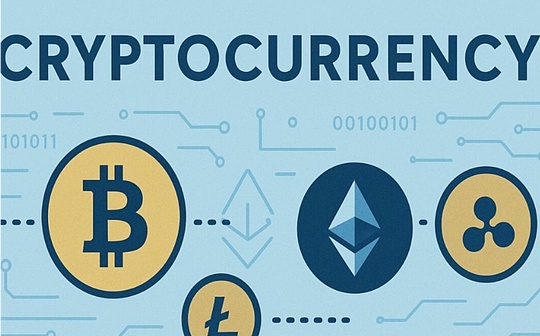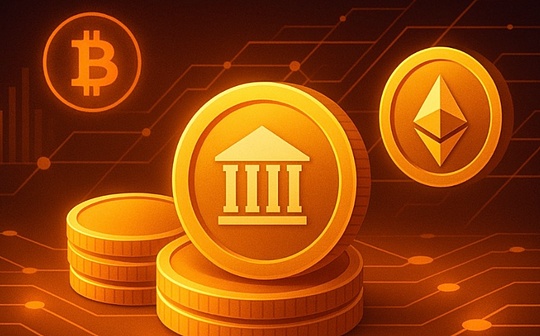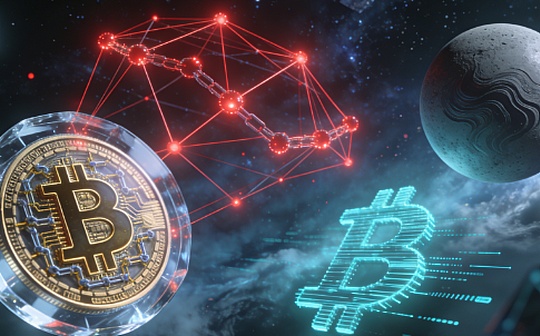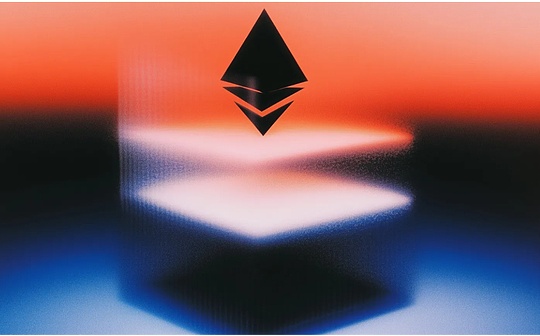
Title: “Genius Act” and New East India Company: How the US dollar stablecoin will challenge the existing fiat currency system and national form
author:rick awsb; Source: X@ricawsb
This is an extremely brilliant asymmetric strategy.The United States is using its rival’s weakest link: the fear of losing control to build its own moat.
1. The Ghost of History: The Digital Return of East India Company
History never simply repeats, but it rhymes.When Trump happily signed his name on the GENIUS Act document, what emerged in my mind was the memory of history – the commercial behemoths that were granted sovereign power by the state in the seventeenth and eighteenth centuries, the East India Company of the Netherlands and the United Kingdom.
This bill seems to be just a technical adjustment of financial regulation, but its deep meaning is to issue a charter for the “New East India Company” in the 21st century, and a change that reshapes the global power landscape has begun.
1a. Charter of new powers
Going back four hundred years ago, the Netherlands East India Company (VOC) and the British East India Company (EIC) were not ordinary traders.They are a mixture of merchants, soldiers, diplomats and colonists with state authorization.The Dutch government granted VOC powers: recruiting troops on their own, issuing currencies, signing treaties with the monarchs of other countries, and even launching wars.Similarly, the royal charter granted by Queen Elizabeth I to EIC also gave her the power to engage in trade monopoly and establish military and administrative functions in India.These companies are the earliest multinational companies in history. They control not simple commodities, but define the lifeblood of globalization in that era – marine trade routes.
Today, what the “Genius Act” does is to grant legitimacy to the power giants in the new era – stablecoin issuers.On the surface, the bill aims to regulate the market and prevent risks by setting reserve standards and requiring asset certification.But its real effect is to create an “legal” stablecoin issuer oligarch group recognized by the US government through screening and certification.These “crowned” companies, such as Circle (USDC publisher), future Tether (if it chooses to comply), and many Internet giants with billions of users such as Apple, Google, meta, and X, will no longer be savagely growing crypto rebels, but will be “franchise companies” officially included in the US financial strategic territory.What they control will be the global trade routes in the new era – the uninterrupted, borderless digital financial track of 24/7.
1b. From trade routes to financial tracks
The power of the East India Company is rooted in a monopoly on physical trade routes.They secured the exclusive rights of the spice, tea and opium trade with gunboats and fortresses and made huge profits from it.The “Digital East India Company” in the new era will exercise its power through the financial track that controls global value flows.When a dollar stablecoin regulated by the U.S. Treasury Department or a specific agency becomes the default settlement unit for global cross-border payments, DeFi (decentralized finance) lending, and RWA (real-world asset) transactions, its issuer has the power to define the rules of the new financial system.They can determine who can access the system, can freeze assets at any address according to instructions, and can set compliance standards for transactions.This is a deeper and more invisible power than controlling physical routes.
1c. Fuzzy symbiosis and confrontation with the state
The history of the East India Company is an epic of the ever-evolving relationship with its motherland.At first, they were agents of the state’s promotion of mercantilism and strategically playing against competitors (such as Portugal).However, the profit-seeking nature of a company has rapidly expanded into an independent center of power.For profit, the EIC did not hesitate to launch wars (such as the Battle of Placi) and engage in immoral trade (such as the Opium trade), repeatedly dragging the British government into the diplomatic and military quagmire that it did not want to participate in.In the end, when the company was on the verge of bankruptcy due to mismanagement and excessive expansion, it had to ask the state for help, which led to the government’s passage of a series of bills (such as the Tea Act of 1773 and the Pete Act of 1784) gradually strengthening supervision, and finally, after the 1858 National Uprising of India, it completely deprived its administrative power and brought its territory to the direct rule of the royal family.
This history previews the possible dynamic relationship between future stablecoin issuers and the U.S. government.At present, these companies are regarded as strategic assets to promote US dollar hegemony and fight against China’s digital RMB.However, once they grow into a “big-to-be-destroying” global financial infrastructure, their own institutional interests and shareholder demands will become crucial.They may make decisions that are contrary to U.S. foreign policy for commercial gain.
This indicates that when the US dollar stablecoin system issued by private institutions is too large, it will inevitably conflict with national sovereignty. At that time, we are likely to see another escalation of the stablecoin bill based on interest games.
The following table clearly compares these two power entities that span time and space, revealing stunning historical similarities:

The ghost of history has returned.The United States is releasing a new East India company through the “Genius Act”.It is dressed in the guise of technological innovation and holds the scepter of blockchain, but its core is the ancient logic of a business empire – a global private business sovereignty that is franchised by the state and will eventually compete for power with the state.
2. Global currency tsunami: the end of dollarization, major deflation and non-dollar central banks
What the “Genius Act” has spawned is not only a new power entity, but also a currency tsunami that will sweep the world.The energy of this tsunami was caused by the collapse of the Bretton Woods system in 1971.It was that historic “liberation” that paved the way for the global conquest of the dollar stablecoin today.For countries with fragile sovereign credit, in the future, it will no longer be the government’s choice of its own currency or the traditional dollar, but the people will choose between a collapsed local currency and a frictionless digital dollar.This will trigger an unprecedented wave of superdollarization, completely ending the monetary sovereignty of many countries and bringing them a devastating deflationary shock.
2a. The ghost of the Bretton Woods system
To understand the power of stablecoins, we must return to the moment when the Bretton Woods system collapsed.The system pegs the US dollar to gold and other currencies to the US dollar, forming a stable structure with gold as the final anchor.However, this system contains a fatal contradiction, namely the “Triffen Difficulty”: as a global reserve currency, the US dollar must continue to flow to the world through the US trade deficit to meet the needs of global trade development; but the continuous deficit will shake people’s confidence in the ability of the US dollar to exchange gold, and ultimately lead to the collapse of the system.In 1971, President Nixon closed the gold exchange window, pronounced the death of the system.
However, the death of the dollar is the beginning of its rebirth.Under the subsequent “Jamaican system”, the US dollar was completely decoupled from gold and became a pure credit currency.It was liberated from the “shackles of gold”, and the Fed could issue currencies more freely to meet domestic fiscal needs in the United States (such as the expenses of the Vietnam War) and global demand for dollar liquidity.This laid the foundation for the hegemony of the dollar over the past half century – an anchorless hegemony that relies on global network effects and the comprehensive national strength of the United States.Stablecoins, especially those recognized by US law, are the ultimate technical form of this post-Bretton Woods system.It elevates the liquidity supply capacity of the US dollar to a completely new dimension, allowing it to bypass the layers of regulatory governments, bypass the traditional, slow and expensive banking system, and directly penetrate into every capillary and every individual’s mobile phone in the global economy.
2b. The advent of Hyper-dollarization
In countries such as Argentina and Türkiye that have been plagued by high inflation and political turmoil for a long time, people spontaneously convert their local currencies into US dollars in order to preserve their wealth. This is the phenomenon of “dollarization”.However, there are many obstacles in traditional dollarization: you need a bank account, you need to face capital controls, and you need to bear the risk of holding physical currency.Stablecoins completely remove these barriers.Anyone with a smartphone can exchange the soon-to-depreciation local currency for a stablecoin anchored to the US dollar at a very low cost in a few seconds.
In Vietnam, the Middle East, Hong Kong, Japan, and South Korea, each U store is rapidly replacing the traditional store change. The Dubai sales office has begun to accept Bitcoin payments, and Yiwu stores can use U to buy cigarettes.
These pervasive payment penetration will turn the stable currency of the US dollar from a gradual process to a tsunami of instantaneous completion.When a country’s inflation expectations rise slightly, capital will no longer be “outflow”, but “evaporate” – instantly disappearing from the local currency system and entering the global crypto network.We can define this attribute as “a replacement enhancement to sovereign currency”.
This will be a fatal blow to governments whose credit is already shaky.The status of the local currency will be completely shaken because the people and enterprises have a more perfect and efficient alternative.
2c. Mass deflation and the evaporation of state power
When an economy is swept by the wave of superdollarization, its sovereign state will lose two core powers: one is the power to make up for the fiscal deficit by printing money (i.e., monetary seigniorage); the other is the power to regulate the economy through interest rates and money supply (i.e., monetary policy independence).
The consequences are disastrous.
First, as the local currency is abandoned on a large scale, its exchange rate will spiral downward and fall into hyperinflation.However, at the level of economic activities denominated in US dollars, there will be severe deflation.Asset prices, wages and commodity values will plummet if measured in US dollars.
Secondly, the government’s tax base will evaporate accordingly.Taxes denominated in rapidly depreciating local currency will become worthless and the national finances will collapse.This financial death spiral will completely destroy the country’s governance capabilities.
This process, starting from Trump’s signing of the Genius Act, will be accelerated through RWA (Real World Assets Linked).
2d. White House vs. Federal Reserve: Power Games within the United States
This currency revolution is not just a blow to the US opponent, it will even cause a crisis within the US.
At present, as an independent central bank, the Federal Reserve controls the US monetary policy.However, a privately issued digital dollar system regulated by the Treasury Department or the White House will create a parallel currency track.The executive branch can indirectly or even directly interfere with the supply and flow of money by influencing regulatory rules for stablecoin issuers, thereby bypassing the Federal Reserve.This could become a powerful tool for the U.S. executive branch to achieve its political or strategic goals (e.g., stimulating the economy in an election year, or precise sanctioning opponents), which in turn triggers a deep crisis of trust in the dollar on monetary policy independence in the future.
3. The financial battlefield of the 21st century: The United States’ “free financial system” against China
If the stablecoin bill is a power reconstruction internally, then externally, it is a crucial piece that the United States has lost in the game of chess with China’s major powers: to support a private, public blockchain-based “free financial system” with the US dollar as its core through legislation.
3a. The financial iron curtain of the new era
After World War II, the United States led the establishment of the Bretton Woods system, with the purpose not only to rebuild the post-war economic order, but also to build a Western economic group that excludes the Soviet Union and its allies in the context of the Cold War.Institutions such as the International Monetary Fund (IMF) and the World Bank have become tools for promoting Western values and consolidating the alliance system.Today, what the “Genius Act” wants to build is the new version of the “Bretton Woods System” in the digital age.It aims to build a global financial network based on the dollar stablecoin, which is open, efficient and ideologically contrary to China’s state-led model.This is a bit like the United States’ arrangement to fight against the Soviet Union’s free trade system, but it’s even more ruthless.
3b. Open encirclement and sealing: licensing system vs. No license required
The strategic paths between China and the United States in digital currency show fundamental differences, which is an ideological war between “openness” and “closed”.
China’s digital RMB (e-CNY) is a typical “permissioned” system.It operates on a private ledger controlled by the central bank, and every transaction and every account are under the strict monitoring of the country.This is a digital “walled garden”, which has advantages in efficient centralized management and strong social governance capabilities, but its closure also makes it difficult to gain the true trust of users around the world, especially those individuals and institutions that are wary of their monitoring capabilities.
In contrast, the stablecoins supported by the United States’ “Genius Act” are built on public blockchains such as Ethereum and Solana.This means that anyone, no matter where they are, can innovate on this network—develop new financial applications (DeFi), create new markets, conduct transactions—without the approval of any centralized organization.The role of the US government is not to become the operator of this network, but to become the “credit guarantor” of the most core asset (USD) in this network.
This is an extremely brilliant asymmetric strategy.The United States is using its rival’s weakest link—the fear of losing control—to build its own moat.It attracts innovators, developers and ordinary users seeking financial freedom to an open ecosystem centered on the dollar.China was invited to participate in a game that it would not be structurally successful: how does a LAN controlled by the state compete with a vibrant financial internet that is open to the world?
3c. Bypass SWIFT: Dimensional reduction strike from the bottom of the kettle
In recent years, one of the core strategies for China and Russia to deal with the hegemony of the US dollar is to establish financial infrastructure that bypasses US control, such as a cross-border payment system that replaces SWIFT (Global Banking Financial Telecommunications Association).However, the emergence of stablecoins has made this strategy seem clumsy and obsolete.Stablecoin transactions based on public blockchains do not essentially need to go through SWIFT or any traditional bank intermediary.The transfer of value is accomplished in a cryptographic manner through a globally distributed network of nodes, which is a brand new track parallel to the old system.
This means that the United States no longer has to struggle to defend the old Financial Castle (SWIFT), but instead opens up a completely new battlefield directly.In this new battlefield, rules are defined by codes and agreements, not treaties between states.When most of the global digital value began to run on this new track, trying to build a “SWIFT alternative” was like working to build a more luxurious horse-driving lane in the era of highways, losing its meaning.
3d. Win the battle of network effects
The core war in the digital age is a war of network effects.Once the platform attracts enough users and developers, it will form a strong gravity, making it difficult for its competitors to catch up.Through the “Genius Act”, the United States is integrating the US dollar, the world’s strongest currency network, with the world’s most innovative and dynamic financial network.The network effects it produces will be exponential.
Developers around the world will prioritize developing applications for US dollar stablecoins with the largest liquidity and the broadest user base.Users around the world will pour into this ecosystem because of their rich application scenarios and asset choices.In contrast, e-CNY may be promoted within specific scopes such as the “Belt and Road”, but its closed, RMB-centric nature makes it difficult to compete with this open dollar ecosystem globally.
To sum up, the “Genius Act” is far from a simple domestic bill.It is the core strategic deployment of the United States in the 21st century geopolitical chess game.It uses the concept of “decentralization” and “openness” to consolidate its most core power – the hegemony of the US dollar in a “small way”.It is not a symmetrical arms race with China, but by changing the terrain of the financial battlefield, it brings competition into a new dimension where the United States has absolute advantages, and launches a dimensionality reduction strike on its opponent’s financial system.
4. “Denationalization” of all things: How RWA and DeFi collapse state control
Stablecoin itself is not the end of the revolution, it is more like a Trojan Trojan horse that invades the city.Once global users get used to holding and transferring value through it, a larger and deeper revolution will follow.The core of this revolution is to transform all valuable assets—stocks, bonds, real estate, art— into digital tokens that can flow freely on global public ledgers.This process, namely “real world asset on-chain” (RWA), will fundamentally cut off the link between assets and the jurisdiction of specific countries, realize the “denationalization” of assets, and ultimately subvert the traditional financial system with banks as the core.
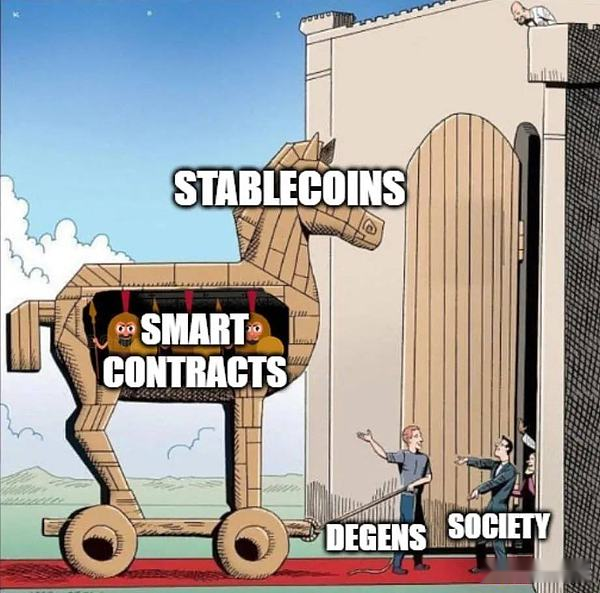
4a. Stablecoin: The “Trojan Horse” leading to the new world
In ancient legend, the Greeks eventually captured the sturdy city of Trojan by offering a huge Trojan horse.Today, stablecoins are playing a similar role.In the eyes of governments and regulators, regulated, asset-staking stablecoins seem to be the “Trojan” that tames the wild horse of the crypto world – a relatively safe and controllable entrance.
However, the paradox of history is that while GENIUS is committed to consolidating state power by promoting “safe” stablecoins, it inadvertently builds the largest user acquisition channel ever for a “dangerous” and truly decentralized non-state currency.
The core function of stablecoins is to serve as a portal to connect the traditional world of fiat currency and the world of crypto assets.They are the “on-ramp” of the encrypted world and the “bridge” across two worlds.An average user may initially just want to enjoy the low cost and high efficiency of stablecoins in cross-border remittances or daily payments, or subsidies given by merchants.But once they download their digital wallet and get used to the on-chain trading model, the distance between them and truly decentralized assets such as Bitcoin and Ethereum is only one click left.
Those platforms that provide stablecoin trading services, such as Coinbase or Kraken, are themselves an all-inclusive crypto asset supermarket.Users come for stablecoins, but will soon be attracted by the high returns provided by the DeFi protocol, or the narrative of Bitcoin as a store of value.From holding USDC to staking ETH to participating in liquidity mining, this process is a natural extension for a user who has already started.
This creates a profound paradox for the country.The country’s short-term goal is to strengthen the dollar hegemony by promoting stablecoins pegged to the dollar.To achieve this goal, the country must encourage and support the development and popularization of user-friendly wallets, exchanges and various applications.However, these infrastructures are technically neutral and protocol-independent.The same wallet can store both regulated USDC and anonymous Monero; the same exchange can trade compliant stablecoins and fully decentralized Bitcoins.
As users’ understanding of the crypto world deepens, their demand for higher returns, greater privacy protection, or truly censorship resistance will grow.At that time, they will naturally shift from providing stablecoins that only provide stable value but no value-added potential to assets that can meet these higher-level needs.
4b. RWA Revolution: Assets break free from the yoke of national borders
If DeFi is the superstructure of this revolution, then RWA is its solid economic foundation.The core of RWA is to transform assets that exist in the physical world or traditional financial systems into tokens on the blockchain through legal and technical processes.
We can imagine a scenario like this:
-
An app with millions of global users in an Apple app store developed by a Chinese team is tokenized through legal and technical means and becomes a digital credential circulating on the blockchain.
-
The token is traded in a on-chain, license-free decentralized finance (DeFi) protocol.
-
After launching a transaction, an Argentine user received the token in his digital wallet within seconds.
The entire process—tokenization of assets, collateralization, minting and transfer of stablecoins—is completed entirely on-chain, bypassing the traditional banking systems of China, the United States (due to its US dollar anchorage) and Argentina.This is not just a superior payment track, it is a parallel financial parallel universe that almost ignores the political and legal boundaries defined by the Westphalian system.
This is exactly the “denationalization of currency” that promotes “denationalization of finance” and ultimately achieves “denationalization of capital”.
When capital can be denationalized, capitalists will naturally denationalize it.
4c. The end of the traditional financial system
This new financial ecosystem powered by stablecoins and based on RWA is a comprehensive impact on the traditional financial system.The core function of traditional finance is essentially an intermediary of information and trust.Banks, securities companies, exchanges, payment companies and other institutions solve the trust issues of both parties to the transaction through their huge capital, complex systems and government licenses, and charge high fees.
Blockchain technology provides a new trust mechanism – “code is law” through its immutable, open and transparent characteristics, as well as rules enforced by code (smart contract).Under this new paradigm, most of the functions of traditional mediation appear redundant and inefficient:
-
Banks’ deposit and loan business can be replaced by decentralized lending agreements.
-
Exchange matchmaking transactions can be replaced by automatic market makers (AMM) algorithms.
-
The cross-border settlement of payment companies can be replaced by the second-level global transfer of stablecoins.
-
Wall Street’s asset securitization can be replaced by more transparent and efficient RWA tokenization.
5. The rise of sovereign individuals and the dusk of the country
When capital can flow without borders, when assets can be separated from jurisdiction, when power transfers from nation-states to private giants and online communities, we reach the end of this change – a new era dominated by the Sovereign Individual and marked by the end of the Westphalian system.This revolution, driven by stablecoins and artificial intelligence (AI), has a profound impact that will surpass the French Revolution because it does not only bring about regime change, it changes the form of power.
(The book of Sovereign Personal is indeed a prophecy of our time)
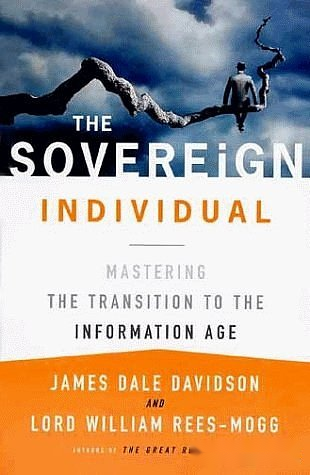
5a. The prophecy of Sovereign Individuals comes true
In 1997, James Dale Davidson and Lord William Rees-Mogg predicted in their shocking book “Social Individuals” that the arrival of the Information Age would fundamentally change the logic of violence and power.They believe that the reason why nation-states can rise in the industrial age is because they can effectively protect large-scale, fixed industrial assets and impose taxes on them.But in the information age, the most important capital—knowledge, skills and financial assets—will become highly fluid and even exist in invisible cyberspace.By then, the country will be like a rancher trying to wrap “winged cattle” with fences, and its taxation and control capabilities will be greatly reduced.
The emergence of stablecoins, DeFi and RWA is the realistic version of “cybermoney” and “cyberreconomy” in this book.Together, they have built a global, low-friction value network, allowing capital to truly grow wings.An elite individual can easily allocate his wealth to RWA tokens around the world and transfer instantly between different jurisdictions through stablecoins, all recorded in public ledgers that are difficult to reach by a state machine.The prophecy of the book “individuals will be free from government oppression” and “wealth holders will be able to bypass the state’s monopoly on currency” are becoming reality.
5b. The end of Westphalia system
Since the signing of the Westphalia Peace Treaty in 1648, the basic unit of world politics has been the sovereign state.The core principles of this system include: states have supreme sovereignty within their territory, sovereign equality among all countries, and the principle of non-interference in their internal affairs.The cornerstone of this system is the state’s absolute control over the population and property within the territory.
The rise of sovereign individuals is fundamentally eroding this cornerstone.When the most creative and productive individuals, their economic activities and wealth accumulation occur in “cyberspace”, the boundaries of territory lose their meaning.The state finds itself unable to effectively tax these globally mobile elites, and its financial base will inevitably be weakened.To stop the outflow of wealth, desperate governments may adopt more radical and authoritarian means, such as the book’s prophetic “hostage-style” taxation and the destruction of technologies that promote individual autonomy.But this will only accelerate the departure of elites and form a vicious cycle.Ultimately, the nation-state may transform into an empty shell, with its function limited to providing welfare and security to less mobile people who cannot enter the global digital economy – a “nanny country” serving the poor.But obviously, such a country has nothing to do with wealth creation
5c. The Last Frontier: The End Battle between Privacy and National Taxation
The next step in this revolution will be privacy.Although the current public blockchain is anonymous (pseudonymous), transactions can still be tracked.However, with the maturity of privacy technologies such as zero-knowledge proofs (such as those employed by Zcash and Monero), future financial transactions will likely achieve complete anonymity and untraceability.
When a globalized, stablecoin-based financial system is combined with powerful privacy technology, it poses the ultimate challenge to the country’s tax capacity.Tax authorities will face an intransparent “black box” that cannot effectively identify the transaction party and taxable income.This will be the ultimate form of “deregulation”, because when a state loses its ability to tax, it also loses the ability to effectively regulate and provide public services.
The French Revolution replaced “monarchy” with “national sovereignty”. The subject of power was replaced from a king to a nation-state, but the regional nature of power has not changed.The revolution started by stablecoins is to use “network sovereignty” and “individual sovereignty” to eliminate “territorial sovereignty of the nation-state.”It is not a transfer of power, but a “decentralization” and “denationalization” of power.This is a more fundamental and thorough paradigm shift, and its far-reaching influence is indeed no less than, or even more than, the French Revolution.We are standing at the dawn of a disintegration of the old world and a new order emerges.This new world will give individuals unprecedented freedom and power, but it will also bring chaos and challenges that cannot be imagined today.

